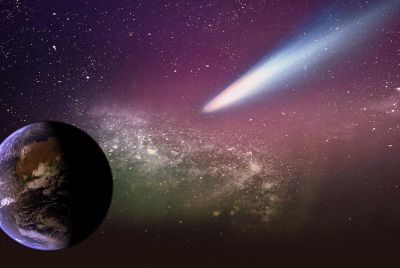3I/ATLAS Accelerates Beyond Expectation — What It Means for Earth and Humanity
Interstellar comet 3I/ATLAS accelerates mysteriously, raising questions.

The interstellar visitor 3I/ATLAS has shown a startling burst of acceleration — and it may redefine how humanity sees its place in the cosmos.
Unusual Motion, Unsettling Questions
When astronomers tracked 3I/ATLAS as it passed by the Sun, they found that it underwent a sudden and unexplained change in movement.
According to Harvard astrophysicist Avi Loeb, the object 'displayed the first evidence of a nongravitational acceleration' at perihelion, measured at a radial acceleration of 135 km/day² and a transverse component of 60 km/day².
Such non-gravitational forces are rare and normally attributable to strong outgassing in comets, but in this case, the volume of gas required would imply the object lost at least 10 % of its mass, Loeb argues.
He told Newsweek: 'We should see a dense cloud of gas around it in November and December'.
If no such cloud appears, he warns that the acceleration 'might constitute a technological signature of a propulsion system'.
Why It Matters for Earth and Humanity
Because 3I/ATLAS comes from beyond our Solar System, its behaviour offers a rare opportunity to test whether interstellar visitors pose only scientific interest or something more consequential.
If natural, it reveals how other star systems eject icy bodies into deep space, which in turn shapes our understanding of planetary formation, galactic recycling, and the cosmic neighbourhood in which Earth resides. If not natural, the implications are profound.
As one expert put it: 'Scientific truth is not decided by authority or popularity but by attention to data.'
Composition and Brightening: A Clue or a Conundrum?
While many comets brighten as they approach the Sun, 3I/ATLAS did so at an unusually fast rate.
Observations from the twin STEREO spacecraft, the SOHO coronagraph, and GOES-19 showed its brightness rose with heliocentric distance r as roughly r^(–7.5 ± 1.0), far steeper than typical comets.
Moreover, photometry found the comet to be 'distinctly bluer than the Sun' at perihelion, a stark finding, since dust scattering normally reddens sunlight.
'The appearance of 3I/ATLAS as bluer than the Sun is very surprising,' Loeb said.
Putting Humanity in Perspective
What does this mean for us on Earth? At a minimum, it means we may have to rethink our assumptions about visitors from beyond our solar neighbourhood, their frequency, their nature, and how much they can teach us.
According to researchers, 3I/ATLAS might be the oldest comet ever seen, perhaps 7 billion years or more in age, having spent eons subjected to cosmic radiation.
From a human-impact angle, the object itself poses no threat. NASA has stated that 3I/ATLAS will remain at a safe distance and is not heading toward Earth.
But the discovery invites reflection. If bodies like this are more common than we thought, our understanding of planetary systems, including our own, could expand dramatically.
The data we collect now will feed into how future space missions are planned, how we monitor the skies, and how we contextualise our world in the grander galaxy.
The Debate: Natural Comet or Something Else?
Not all scientists agree that 3I/ATLAS is extraordinary beyond a normal comet. Professor Darryl Seligman (Michigan State University) told Newsweek that 'comets have nongravitational accelerations all the time' — caused by subtle outgassing that acts like a rocket thrust.
On the flip side, Loeb emphasises a growing list of anomalies: large size, high speed, close alignment to the ecliptic, unusual chemical composition (like a high CO₂ to H₂O ratio), and unexpected brightening.
Whether the acceleration is natural or engineered remains unresolved, but regardless of the outcome, the implications reach humanity's place in the cosmos, our readiness for interstellar discovery, and our view of what lies beyond our solar system.
What to Watch Next
Scientists will watch carefully this coming December when 3I/ATLAS makes its closest approach to Earth (about 167 million miles away).
If a dense gas cloud materialises, it would support the outgassing/comet hypothesis. If not, the door to more speculative theories opens wider.
Meanwhile, deeper compositional studies, including data from the James Webb Space Telescope and other instruments, indicate that long-term cosmic-ray irradiation has changed the outer layers of the object, perhaps down to 15–20 metres, which may mean we are not seeing its original interior but a heavily processed skin.
🚀 BREAKING: Interstellar Comet 3I/ATLAS Shows Mysterious Acceleration 🌌
— Markus Hohenwald (@markus_pyrodice) November 3, 2025
After passing the Sun, 3I/ATLAS displayed unexpected non-gravitational acceleration on Oct 29, 2025. Two competing explanations:
☄️ Natural Hypothesis: If caused by comet outgassing, the nucleus would… pic.twitter.com/AzDxfEAbS8
Final Thoughts
3I/ATLAS's unexpected acceleration is not just a quirk of a passing rogue object.
It is a moment for humanity to pause and ask: What might lurk beyond our solar system? How many interstellar visitors carry data, clues, or surprises? And what does our capacity, scientific, technological, and philosophical, look like when faced with a cosmic guest whose origins may lie light-years away?
In this sense, the acceleration of 3I/ATLAS may turn out to be not only a matter of science but also a question about humanity's readiness for the wider universe.
© Copyright IBTimes 2025. All rights reserved.





















